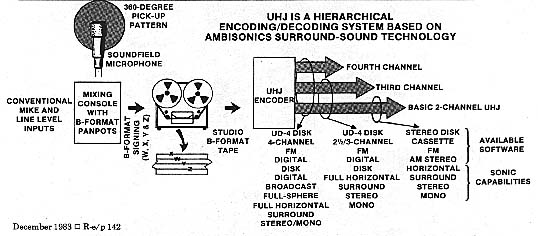
Reprinted from Recording Engineer/Producer,
December 1983, with kind permission of Nigel's family.
Published
here in his memory.
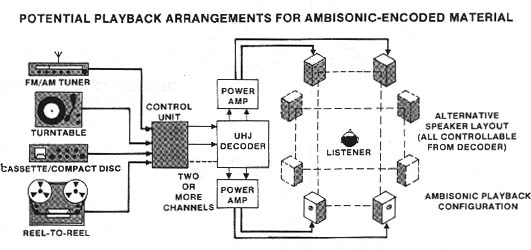
Many engineers and producers would consider that the biggest limitation faced by those of us involved with recording and broadcasting conventional high-quality audio is no longer distortion, noise, or poor frequency response. It is rather the "cardboard cut-out" sound images caused by the limitation of having just two loudspeakers available for stereo reproduction. Good as stereo may be, it cannot capture the three-dimensional world of sounds. Imagine birds singing overhead, applause from an audience situated all around, or the sound of footsteps beneath you as you walk; imagine the all-surrounding reverberation of a large concert hall. This is what the Ambisonic surround- sound system of recording and reproduction can achieve.
Ambisonics works by using the psycho-acoustics of human directional hearing to capture all directions of sound around the listener; its principles of operation are based on over a decade of research and development. Unlike "Quadraphonics" - which was basically two stereo systems - one placed in front of the listener, and one behind - Ambisonics can create convincing and accurate localized phantom images even between side loudspeakers. Furthermore, the listener can move around the listening area, and face in any direction without losing the sound image.
Ambisonics is indeed a total systems approach to capturing surround sound information, and is aimed at meeting the widest range of professional and consumer requirements - from the needs of a listener with a pocket AM radio, to the audiophile listener with a custom multi speaker home system. Not only is it compatible with existing mono and stereo media, Ambisonics also offers practically unlimited capability of meeting both near and distant future needs. Beyond stereo, the continuing interest in four-speaker sound can be satisfied by Ambisonics via existing records, tapes, and radio.
The UHJ (standing for "Universal
HJ") system of encoding directional sounds into two or more transmission channels,
developed in conjunction with the British Broadcasting Corporation, conveys
the Ambisonic soundfield to the final listener, and was designed to achieve
outstanding mono and stereo compatibility. No mono listener should lose any
important sonic information, no matter where the producer decides to place it
in space. In addition, a stereo listener tuned into a UH J broadcast not only
hears a full-width stereo presentation, but also enjoys an enhanced sense of
depth and focus not possible with conventional stereo transmission systems.
And, of course, the listener equipped with psycho-acoustically optimized Ambisonic
surround sound decoders hears the precise pattern of surround sound intended
by the producer.
As will readily be appreciated, this hierarchical system provides the option of using two, three or four channels with UHJ, depending on how many channels are available for storage or transmission. For example, in FM broadcasting, a recent decision by the FCC has made available three- and four-channel multiplex FM. Naturally, broadcasters not yet ready to update their equipment can still broadcast UHJ in its two-channel form. While present-day LPs, cassettes, and Compact Discs convey two channels, the CD standard allows for future marketing of disks with up to four audio channels. Already, a number of two-channel UHJ Compact Discs are on the market.
All Ambisonic systems, whether utilizing two, three, or four transmission/storage channels, can reproduce surround sound through four or more loudspeakers. Most listeners will probably prefer to use just four speakers for the time being; however, even better results are obtained if six or more speakers are used, since the Ambisonic system does not convey sounds for just four loudspeaker channels, but a total, all-direction soundfield. For this reason, sound can be tapped off from any direction to re-create the soundfield via practically any number of loudspeakers.
International patent rights covering
Ambisonic technology are held by the NRDC (National Research and Development
Corporation) in Britain, and incorporate inventions from the USA, Japan, and
Britain. All aspects of this technology are available to manufacturers under
license.
B-Format signals are produced by most Ambisonic studio production equipment, and for dissemination to consumers are converted to UH J formats-- two-, three-, or four-channel --by means of a UHJ encoder. The studio handling of Ambisonics and its conversion to a usable consumer format for broadcast or commercial release is illustrated in the accompanying diagram, which shows several of the options involved.
So far, Ambisonics technology has led to the development of a Soundfield Microphone manufactured by Calrec Audio, and which has been praised by many users for its high degree of realism and accuracy; a Transcoder that offers both Encode (B Format to two-channel UH J) and Transcode (four-channel or "Quad" to UHJ two-channel); and a Multi-Track Pan/Rotate unit - the latter two devices being manufactured by Audio + Design.

The Pan/Rotate unit enables a whole new range of creative sound manipulation techniques, such as full- range positional control to be achieved for both single (mono-miked) sound sources, or composite soundfields. Other Ambisonic units currently available include the Calrec UHJ Encoder, which encodes four-channel B Format to two- or three-channel UHJ for broadcast or disk cutting; the Audio + Design Converter, which enables a mixing consoleís panpots to be used for soundfield localization - thus freeing up the Pan/Rotate unit for dynamic panning effects; the Minim AD12 Decoder, which decodes B Format or UHJ two-channel material; the Audio + Design Control Room Decoder, which will decode two- and three-channel UHJ signals and allows comparison with original four-channel B-Format signals; plus several UHJ decoders designed for consumer use.
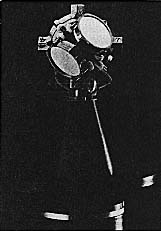 Although
the Calrec Soundfield Microphone has been available for some time now, October
of this year saw the introduction of a Mark 4 version, whose availability also
coincides with release of the above-mentioned Ambisonic encoders, decoders,
and effects units. As many readers may already be aware, the Soundfield Microphone
system comprises a microphone body and electronics, plus associated control
unit. The body houses four mike capsules arranged in a tetrahedral array, with
electronic compensation to remove the effects of capsule spacing. The Soundfield
mic is designed to capture accurately the sound that exists at a point in space;
in other words, it comprises a three-dimensional coincident "pair." Of primary
importance is the systemís ability to capture a complete spherical
soundfield that can be manipulated by panning and steering the signals in both
the horizontal and vertical planes. This manipulation can be accomplished in
either real time - as perhaps the ultimate boom mic - or later in post- production
from the B-Format signals recorded on tape. Azimuth and Elevation controls govern
rotation and tilting of the microphoneís orientation in space, while
a Dominance or Zoom control allows the direction of dominant sound to be moved
to the front or back. (For example, to give an orchestra or band dominance over
audience noise, and enable not only manipulation of the effective polar pattern
- from omni through all the intermediate cardioids to figure-of- eight - but
also the amplitude of the respective dominant signals.)
Although
the Calrec Soundfield Microphone has been available for some time now, October
of this year saw the introduction of a Mark 4 version, whose availability also
coincides with release of the above-mentioned Ambisonic encoders, decoders,
and effects units. As many readers may already be aware, the Soundfield Microphone
system comprises a microphone body and electronics, plus associated control
unit. The body houses four mike capsules arranged in a tetrahedral array, with
electronic compensation to remove the effects of capsule spacing. The Soundfield
mic is designed to capture accurately the sound that exists at a point in space;
in other words, it comprises a three-dimensional coincident "pair." Of primary
importance is the systemís ability to capture a complete spherical
soundfield that can be manipulated by panning and steering the signals in both
the horizontal and vertical planes. This manipulation can be accomplished in
either real time - as perhaps the ultimate boom mic - or later in post- production
from the B-Format signals recorded on tape. Azimuth and Elevation controls govern
rotation and tilting of the microphoneís orientation in space, while
a Dominance or Zoom control allows the direction of dominant sound to be moved
to the front or back. (For example, to give an orchestra or band dominance over
audience noise, and enable not only manipulation of the effective polar pattern
- from omni through all the intermediate cardioids to figure-of- eight - but
also the amplitude of the respective dominant signals.)
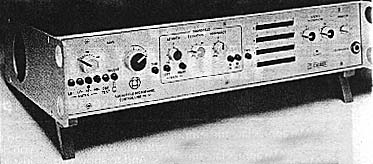
Both B- Format inputs and outputs are available on the control unit, as well as conventional stereo outputs. It is important to realize in the case of the Soundfield Microphone, that quite apart from surround-sound applications, for conventional mono/stereo reproduction the microphoneís polar diagram may be synthesized either in real time, or subsequent post-production from B Format.
Ambisonic production has perhaps been held back because, until now, only the Soundfield Microphone has been available for recording live music, drama, speech etc. Since most of the recording and broadcast production industry relies on mass-market multi- track derived music, Ambisonics has not had enough to offer. However, the recent introduction of processing equipment, including the Multi-track Pan/Rotate, Converter, and Transcoder units mentioned above, should change this situation, since they enable mono-miked sources to be manipulated within an Ambisonic soundfield.

The Pan/Rotate unit features eight continuously rotatable sine/cosine panpots, plus a switchable control that will rotate the entire soundfield through 360 degrees. The panpots can be switched pre or post (before/after) the rotate control. Apart from the eight inputs from the mixing console there . are two external B-Format inputs - one patched before and another after the rotate control - which may be used to cascade these or similar units Each panpot includes a "radius vector" control that allows sounds to be panned through the listenerís position from one side of the soundfield to the other - quite apart from the ability to move sounds around the circumference of the soundfield. The B-Format output from the Pan/ Rotate Unit can be sent to a four-track recorder, or direct to a suitable encoder to produce a UHJ two channel master tape for broadcast or disk cutting, or to a three-channel encoder for enhanced surround-sound broadcast.
The Converter unit allows a conventional consoleís panpots to be utilized for soundfield localization. The unit contains two independent B-Format groups, each with separate outputs. Five inputs feed each converter group, and are designed to be connected to four console output groups, plus an echo send bus. The echo send supplies a mono reference signal, while the group inputs provide level information that is "converted" with the mono signal into a B-Format signal. Thus, a console panpot can be used as an Ambisonic localization control, simply by turning up the echo send level, and routing the mono source to two of the four groups.
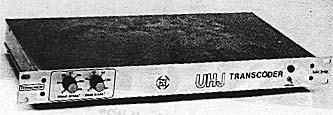
The Transcoder takes four
inputs (corresponding to a front and a rear stereo pair - for example, an existing
"quad" mix) and "transcodes" these into a UHJ two-channel signal. Control of
the width of front and rear sound- stages is possible, and may be varied between
0 and 180 degrees in the front sector, and 0 to 150 degrees in the rear. Panning
between the front two groups via the console panpots moves the signal across
the entire width of the front stage. [The unit can also simultaneously encode
a B-Format signal into UHJ --RE]
Using the equipment described above, the creative effects possibilities in Ambisonics, including non-realistic events such as sound sources moving around and through the listenerís head, are practically endless. There are few pitfalls, however. It is important to remember when mixing Ambisonic material which may be monitored by the consumer in stereo that although the system is exceptionally mono/stereo compatible, signals panned around the rear sector of the soundfield, for example, will be "collapsed" to the front in stereo. As a result, care should be taken with placement to avoid cluttering the stereo image. This can easily be achieved by simply monitoring in stereo from time to time as a check of surround- sound/stereo compatibility.
Because Ambisonics uses phase and amplitude information to localize a source, rather than just amplitude, the image is far less dependent on the listenerís position (in both stereo or surround sound monitoring layouts), which means that the listener can move around the room without losing image stability. In both stereo and surround-sound monitoring arrays, the resultant image is more stable and can thus be localized better. Furthermore, the apparent stereo width of an Ambisonic recording played back in stereo is perceived to be wider than the speaker separation; in fact it is possible to produce stereo effects that appear to move round the room without the benefit of an Ambisonic decoder. (Similar results can be obtained using stereo headphones.)
Monitoring setups for horizontal surround-sound (that is, without height or Z-channel information) is quite simple, a suitable decoder plus four speakers and additional amps being all that is required. (Six or more speakers are necessary for full sphere or "periphonic" reproduction.)
It must be stressed that Ambisonics has the potential of constituting at least as an important step forward for audio as digital technology. In its various hierarchical, inter-compatible forms, Ambisonics material may be stored digitally or by conventional analog means, and broadcast techniques using phase-quadrature modulation of the third channel have been successfully demonstrated in Britain by the Independent Broadcasting Authority, and is now permitted in the United States. All the hardware to record and disseminate Ambisonic surround-sound information is now in place, with more on the way. It is now just a matter of time before Ambisonics will be heard regularly on record, on the air and, perhaps, with video.
